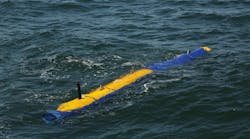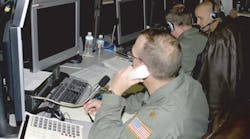PLYMOUTH, Minn. — Microelectronics scientists at two U.S. semiconductor companies are perfecting an application-specific integrated circuit (ASIC) for high-speed data communications that is able to move photons and electrons over the same substrate.
This new technology called the Optoelectronic Application Specific Integrated Subsystem — OASIS, for short — promises not only to shrink the size and power consumption of communications ICs, but also to enable systems integrators to move data from the chip directly to optical media such as optical fiber without the need for electronic-to-optical converters.
OASIS technology also may lead the way to revolutionary new approaches to all-optical super-high-speed data processing.
Experts at the Honeywell Defense & Space Electronics unit in Plymouth, Minn., and SiOptical Inc. in Allentown, Pa., are partners in the OASIS program that seeks to fabricate commercial products in early 2006, says Greenville Hughes, product line manager for commercial electronics at Honeywell Defense & Space.
SiOptical experts developed the OASIS technology, which uses microelectromechanical systems (MEMS) to move light onto the chip substrate, Hughes says. SiOptical has access to the commercial telecommunications market, while Honeywell Defense & Space has access to the military and aerospace markets.
Honeywell engineers are concentrating on applying OASIS technology to their company's radiation-hardened silicon-on-insulator (SOI) and complementary metal-oxide semiconductor (CMOS) processes, in which Honeywell experts have achieved 0.15-micron chip geometries.
"SOI and CMOS processes can handle this," Hughes says. "We can conduct photons and electrons through the same chip substrate. We are demonstrating this technology; it's not pie-in-the-sky type stuff."
OASIS devices fabricated with Honeywell's rad-hard processes would be particularly applicable to defense programs such as Transformational Satellite Communications (TSAT), space-based radar, and multi-user objective systems, experts say.
The foundation for commercializing OASIS technology is a joint Honeywell/SiOptical project called SerDes, which is short for serializer/deserializer technology. SerDes, a serial architecture for high-speed communications networks, seeks to speed data throughput in new and existing systems by rapidly converting data from serial to parallel, or parallel to serial streams.
SerDes is for electrical and optical communications systems for moving data chip-to-chip, board-to-board within a cabinet, and cabinet-to-cabinet. SerDes also will be produced on Honeywell's rad-hard SOI fabs.
Honeywell and SiOptical scientists are pursuing the SerDes and OASIS approaches in response to the ever-increasing speeds of digital communications systems such as satellites that pass information fare too quickly for conventional parallel backplane-based data-passing methods.
SerDes, will move data at 10 gigabits per second over industry standards such as the 10 Gigabit Attachment Unit Interface, better known as XAUI, as well 10-gigabit Ethernet, Fibre Channel Rapid IO, and Infiniband.
SerDes — and the follow-on OASIS program — are in place to reduce the number of components on a system, achieve significant better data speed and bit error rates, and support high data rates over several protocols that are necessary for advanced communications systems.


